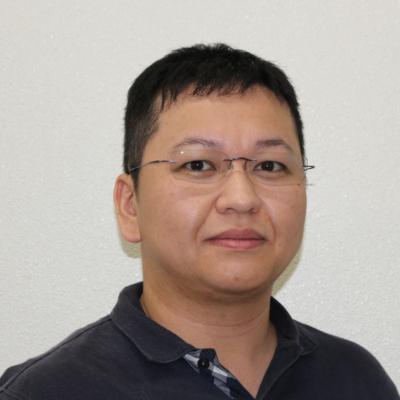|
Title |
Associate Professor |
|
Researcher Number(JSPS Kakenhi) |
20645478 |
|
Laboratory Address |
1 Senbaru,Nishihara,Okinawa |
|
Laboratory Phone number |
+81-98-895-8711 |
|
|
|
KUNITA Itsuki
|
|
|
Current Affiliation Organization 【 display / non-display 】
-
Duty University of the Ryukyus Faculty of Engineering School of Engineering_Computer Science and Intelligent Systems Program Associate Professor
-
Concurrently University of the Ryukyus Graduate School of Engineering and Science Computer Science and Intelligent Systems Associate Professor
External Career 【 display / non-display 】
-
2011.06-2013.09
Future University Hakodate (Faculty of Systems Information Science) PD
-
2013.10-2015.03
Hokkaido University (Research institute for Electronic Science) PD
-
2015.04-2016.11
Kumamoto University (International Research Center for Medical Sciences) PD
-
2016.12-2017.03
University of the Ryukyus (Department of Information Engineering, Faculty of Engineering) Instructor
-
2017.01-2021.03
Research Areas 【 display / non-display 】
-
Natural Science / Biophysics, chemical physics and soft matter physics
-
Life Science / Biomedical engineering
-
Informatics / Life, health and medical informatics
-
Informatics / Intelligent robotics
-
Informatics / Intelligent informatics
Published Papers 【 display / non-display 】
-
Dynamic remodeling model based on chemotaxis of slime molds
Uza, M; Kunita, I
BIOINSPIRATION & BIOMIMETICS ( Bioinspiration and Biomimetics ) 19 ( 5 ) 2024.09 [ Peer Review Accepted ]
Type of publication: Research paper (scientific journal)
-
Access this article
-
Search related information
-
-
Estimating individual exposure to predation risk in group-living baboons, Papio anubis.
Suire A, Kunita I, Harel R, Crofoot M, Mutinda M, Kamau M, Hassel JM, Murray S, Kawamura S, Matsumoto-Oda A
PloS one ( Public Library of Science (PLoS) ) 18 ( 11 ) e0287357 - e0287357 2023 [ Peer Review Accepted ]
Type of publication: Research paper (scientific journal)
-
Access this article
-
Search related information
-
-
A Three-Dimensional Scanning System for Digital Archiving and Quantitative Evaluation of Arabidopsis Plant Architectures.
Kunita I, Morita MT, Toda M, Higaki T
Plant & cell physiology 2021.05 [ Peer Review Accepted ]
Type of publication: Research paper (scientific journal)
-
Access this article
-
Search related information
-
-
Three-dimensional reconstruction of Arabidopsis plant architecture
Kunita Itsuki, Kinjo Airi, Toda Masashi, Higaki Takumi
PLANT MORPHOLOGY ( The Japanese Society of Plant Morphology ) 33 ( 1 ) 67 - 69 2021
Type of publication: Research paper (scientific journal)
-
Access this article
-
Search related information
-
-
Kentaro Ozawa, Hirotaka Taomori, Masayuki Hoshida, Itsuki Kunita, Shigeru Sakurazawa, Hajime Honda
Biophysics and Physicobiology ( Biophysics and Physicobiology ) 16 1 - 8 2019.01 [ Peer Review Accepted ]
Type of publication: Research paper (scientific journal)
-
Access this article
-
Other Papers 【 display / non-display 】
-
Cellular Ethological Dynamics in Diorama Environments
Nishigami, Y; Kunita, I; Sato, K; Nakagaki, T
JOURNAL OF THE PHYSICAL SOCIETY OF JAPAN ( Journal of the Physical Society of Japan ) 92 ( 12 ) 2023.12 [Refereed]
-
Proposal of a self-organizing formation building Model based on difference in behavior due to Baboon sexage attributes
Nonoka HOMMA, Akiko MATSUMOTO, Itsuki KUNITA
1F2-02 2023.12 [Refereed]
-
A customer behavior classification method using trajectory clustering
Kanon MIYAZATO, Itsuki KUNITA
2E2-06 2023.12 [Refereed]
-
The physarum model by membrane potential change proceed growing
Megumi UZA, Itsuki KUNITA
2B2-02 2023.12 [Refereed]
-
Effects of interactions between agents on swarm control in multi-shephering.
Keigo NAKADA, Akiko MATSUMOTO, Itsuki KUNITA
1F2-04 2023.12 [Refereed]
Presentations 【 display / non-display 】
-
Reforming network routes using phase changes in slime molds
Megumi Uza, Itsuki Kunita
SCIS&ISIS 2024 2024.11 - 2024.11
-
Impact of Shepherd Interaction on Flock Dynamics in MultiShepherding
Keigo Nakada, Akiko Matsumoto-Oda, Itsuki Kunita
SCIS&ISIS 2024 2024.11 - 2024.11
-
Relationship between the Proportion of Agents with Different Repulsion Distances and Their Spatial Arrangement
Nonoka Homma, Akiko Matsumoto-Oda, Itsuki Kunita
SCIS&ISIS 2024 2024.11 - 2024.11
-
Biological rhythm in the cirral activity of the acorn barnacle Fistulobalanus albicosta
Aoi Katayama , Hiroki Takekata , Itsuki Kunita , Akihiro Takemura
The Crustacean Society Summer Meeting 2024 2024.05 - 2024.06
-
Biological rhythm in the acorn barnacle Fistulobalanus albicostatus: The cirrus behavior synchronizing to light-dark and tidal cycles
Aoi Katayama, Hiroki Takekata, Itsuki Kunita, Akihiro Takemura
OIST-CNRS Joint Symposium on West Pacific Marine Biology 2024.04 - 2024.04
Academic Awards 【 display / non-display 】
-
Best Paper Award
2015.09 The 6th Japan-China-Korea MEMS/NEMS 2015 Angiogenic sprouts form perfusable vascular networks inside multicellular spheroid
Winner: Yuji Nashimoto, Itsuki Kunita, Akiko Nakamasu, Yusuke Torisawa, Hisako Imamura-Takigawa, Hidetoshi Kotera, Koichi Nishiyama, Takashi Miura, Ryuji Yokokawa
Grant-in-Aid for Scientific Research 【 display / non-display 】
-
Grant-in-Aid for Scientific Research(C)
Project Year: 2023.04 - 2027.03
Direct: 3,600,000 (YEN) Overheads: 4,680,000 (YEN) Total: 1,080,000 (YEN)
-
Heuristic algorithm of exploration and exploitation to the space geometry in ciliates and amoebae
Grant-in-Aid for Transformative Research Areas (A)
Project Year: 2021.09 - 2026.03
Direct: 92,400,000 (YEN) Overheads: 120,120,000 (YEN) Total: 27,720,000 (YEN)
-
Grant-in-Aid for Scientific Research(C)
Project Year: 2019.04 - 2023.03
Direct: 3,400,000 (YEN) Overheads: 4,420,000 (YEN) Total: 1,020,000 (YEN)
-
Imaging analysis on cell geometry during mechanical optimization in leaves
Grant-in-Aid for Scientific Research on Innovative Areas (Research in a proposed research area)
Project Year: 2018.06 - 2023.03
Direct: 44,200,000 (YEN) Overheads: 57,460,000 (YEN) Total: 13,260,000 (YEN)




